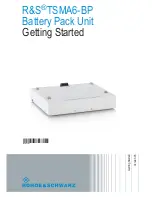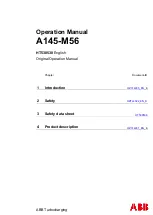
15
SENS IQ Technical Manual
Service hotline: 1.800.742.2326
1.303.678.7500
7.
BATTERY CHECK BUTTON AND STATUS LED
- Press BATT CHCK to activate the Battery Check feature (see
Section 8.
4). The status LED displays test progress and outcome. Amber
indicates the test is in progress. Green indi-
cates the
Battery Check
passed successfully. Red indicates the
Battery Check test
failed.
The status LED is blank if
a Battery Check test has not occurred, if the Battery Check feature is disabled, at start up after a previously passed test,
after a field battery change, if a Battery Check test is terminated prematurely, or after pressing the ENTER/BACK key
twice to clear the alarm LED.
If the Battery Check is successful the BATTERY LED will also be Green. If the Battery Check fails the DC
SYSTEM LED and BATTERY LED will be Red.
8.
AC INPUT LED
- Indicates AC input power status
.
Green indicates correct AC input power is present, Amber
indicates AC voltage is out of specification, Red indicates no AC power is present.
9.
CHARGER LED
- Indicates charger status. Green indicates a normally operating charger, Amber indicates a
Charger Over Temperature warning, Red indicates an Over Voltage Shutdown or Charger Failure alarm. See LCD
display for specific alarm indication while alarm is present.
10.
CHARGER DC BREAKER LED
- Indicates DC breaker status
. Green indicates DC breaker is closed, Red indi-
cates DC breaker is open.
11.
DC VOLTS LED
- Indicates DC output voltage status. Green indicates DC voltage is normal, meaning above Low
DC Voltage alarm setting and below High DC Voltage alarm setting. Amber indicates a Low DC Voltage or Bat-
tery End-of-Discharge alarm, Red indicates a High DC Voltage or Over Voltage Shutdown alarm.
12.
BATTERY LED
- Indicates battery status. Green indicates that battery passed a Battery Check, Amber indicates a
Battery Over Temperature alarm, Red indicates a Battery Backwards or Battery Check Fail alarm.
Blank indicates
a
Battery Check test has not occurred, the Battery Check feature is disabled, or the battery type or cell count has changed.
8.3.1
Float Mode
The FLOAT mode is used to maintain the battery in its fully charged state, and is the normal setting for all
batteries and the preferred setting for most Valve Regulated Lead Acid (VRLA) batteries. With the charger
in the FLOAT setting, the output voltage is maintained at the float voltage setting.
8.3
Charge Mode Select
The charging mode of the battery charger is controlled via the front panel CHARGE MODE SELECT button, as
shown in
FIG 4
. The charger may be operated in any one of three modes, FLOAT, EQUALIZE or AUTO.
CAUTION:
Always read and follow battery manufacturer’s recommendations
regarding float and equalize charge settings.
8.3.1.1 Battery Eliminator Operation
The charger is designed to operate in a stable fashion when driving DC loads either with or without a
battery connected. Chargers intended for use without a battery connected should be adjusted so that
Float output voltage is set to the nominal rating of the charger and Equalize Mode, Temperature
Compensation, Battery Check button and automatic Battery Check are disabled (see Section 8.
6
.2).
8.3.2
Equalize Mode
The EQUALIZE mode is used to ensure that all battery cells in a battery string are charged to the same level,
and also used when faster charging of the batteries is desired, such as recovery after a power failure. The output
voltage of the charger is typically 5%-10% higher in EQUALIZE mode than in FLOAT mode.
8.3.2.1 Manual Equalize Mode
Press the front panel CHARGE MODE SELECT button to engage manual EQUALIZE mode. The Amber
Equalize LED will illuminate. With the charger in the EQUALIZE setting, the output voltage is maintained at
8.2 Commission
Batteries
(available with version 3.00 or later firmware)
Initially charge/commission zero charge batteries or when recommended by a battery manufacturer by scrolling to
the COMMISSION CHRG menu on the front panel User Interface Display. The user interface jumper must be in
the unlock position to engage commissioning (see Section 8.7). Once commissioning has started, the jumper
should be placed back in the lock position. See Section 8.6.2 to adjust commission charge settings.
Commissioning is timed and uses configurable voltage and current settings. Commissioning is not available for
VRLA batteries. During commissioning, High DC and Over Voltage Shutdown alarms occur at 102% of the
commissioning charge voltage and temperature compensation is not active. After commissioning completes, the
charger will automatically revert to the settings configured for normal charging, including temperature
compensation and high voltage alarms.
















































